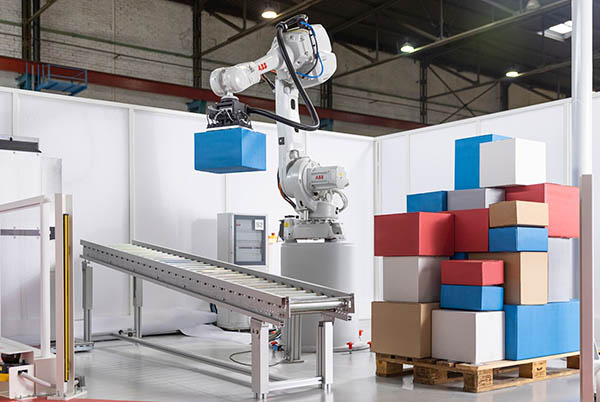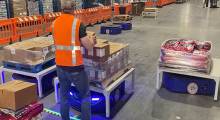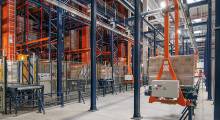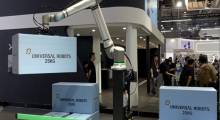ABB Robotics & Discrete Automation yesterday launched its ABB Robotic Depalletizer system for handling complex tasks in the logistics, e-commerce, healthcare, and consumer packaged goods industries. Using machine vision software, the depalletizer can quickly assess a wide variety of box types, said the company. Along with the RobotStudio digital twin software, this enables customers to efficiently process assorted loads with little engineering effort and setup time, said ABB.
“Changes in consumer behavior are leading to a rise in new sales channels such as omnichannel, direct-to-consumer (D2C), and e-commerce,” said Marc Segura, president of ABB’s robotics division. “These, in turn, are driving the need for more flexible and efficient order-fulfilment and distribution infrastructures.”
“With the ability to depalletize boxes stacked in a variety of configurations from single and mixed pallets, ABB´s Robotic Depalletizer helps to meet this need, allowing faster and more accurate handling of a wide range of goods ready for the next stage in the distribution process,” he said.
ABB Robotics & Discrete Automation is a division of Sweden-based ABB Ltd. that provides automation and digital services for the automotive, electronics, and logistics industries, among others. It said it has shipped more than 500,000 robots as it helps customers of all sizes improve output quality and increase productivity. Auburn Hills, Mich.-based ABB Robotics employs more than 10,000 people at over 100 locations in more than 53 countries.
Robotic Depalletizer relies on machine vision
Not only are depalletizing tasks growing more complex as the composition and configuration of pallets becomes more varied, but these previously manual sorting jobs are typically characterized by high staff turnover and increased recruitment costs.
ABB said its Robotic Depalletizer solves these problems by using machine vision and machine learning algorithms to quickly and efficiently process pallets of up to 2.8 m (9.1 ft.) high. It claimed that it is the only product currently capable of operating at these heights.
The Robotic Depalletizer's software uses the information gathered by the vision sensor to provide the robot with a suitable grasping point for each box. The robot then picks up the box – weighing up to 30 kg (66.1 lb.) – and places it on either another pallet or an outfeed conveyor. The system can work accurately at a peak rate of up to 650 cycles per hour, 24 hours a day, said ABB.
The camera enables the robot to detect specific carton boxes on pallets, allowing for reliable depalletizing of several different load types, according to the company. These include pallets comprised of a single type of box in defined layers; “rainbow” pallets containing a number of different box types; and mixed pallets, which have a wide range of boxes with varying weights, shapes, and materials.
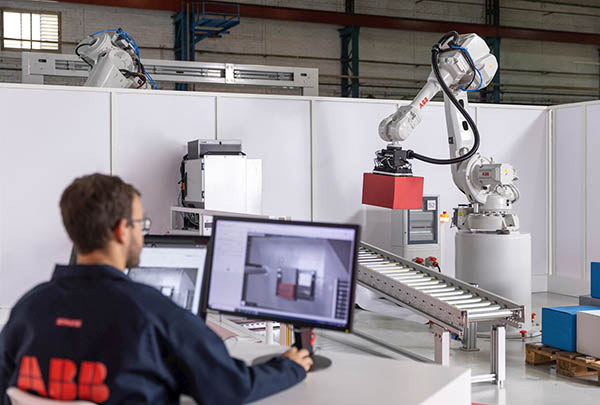
ABB offers flexible configurations
ABB said the Robotic Depalletizer comes with a range of four- and six-axis robot arms to provide the flexibility required to perform either simple or more complex depalletizing tasks.
In addition, RobotStudio allows customers to build bespoke application simulations with their own box dimensions, weights, and pallet patterns, said the company. Customers can tailor modular collaborative layouts to suit their needs and incorporate advanced lidar and radar scanner and light-curtain systems to scan the robot’s surroundings and ensure worker safety.
To further enhance flexibility, ABB said its Robotic Depalletizer can be integrated with its autonomous mobile robots (AMRs, recently acquired with ASTI Mobile Robotics Group) for handling goods in warehouses and dispatching centers. It offers setup times as short as three weeks, said ABB.
Article topics
Email Sign Up

